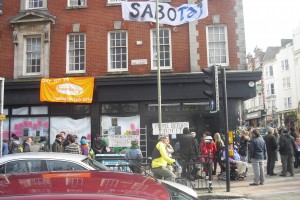Sabotaj
The Sabotaj Story
In Brighton there is a tradition of resistance to the invasion of supermarkets, with squats sometimes being used as a means of community resistance. Examples would be the Locomotive Works (2002) and the Lewes Road Community Garden (2009-2010). The Sabotaj squat (2011) was a short-lived recent action and here one participant in the Squatters Network of Brighton shares some personal thoughts.
When concerned locals found out in December 2010 that Sainsburys intended to muscle in on Kemptown, they were furious. St. James Street already had a Co-operative, a Morrisons and a Tescos. A Sainsburys coming on the very same street was a step too far in the wrong direction, especially since they wanted to take over Taj, a Brighton institution. Taj was a family owned supermarket with three branches in Brighton selling exotic fruit and veg. Not a truly local, organic shop, but still much better than a cloned supermarket.
A campaign was started to stop Sainsburys taking over the landmark building on the Old Steine at the foot of St. James Street, but unfortunately Taj had gone into administration and Sainsburys had taken on the lease on the shop. What’s worse, they did not need to get any planning permission except for minor things like signage since Taj already had all the relevant permissions. This only goes to show the stupidity of planning law, which sees a local shop and a Sainsburys “Local” as the same, and allows Sainsburys to take on previously granted but unused permissions, rather than reviewing them. At Council meetings the common refrain was that councillors did not want another supermarket, but their “hands were tied.” The one small victory was that Sainsburys did not get granted an alcohol license, thanks to the campaigners’ efforts.
In the absence of anything else happening, what was needed was an occupation, and this happened in February 2011.
Despite the police doing their utmost to evict illegally by trying to kick the door in and threatening bystanders with arrest, the squatters held it down. An initial meeting in the shop, which was organised at short notice, still drew more than a hundred people. There were a lot of ideas on how to use the space, ranging from art exhibition to people’s supermarket. The common theme was that people wanted to hold onto to the building rather than give it into the hands of a multinational corporation. Radical and liberal views could agree at least on that. The name Sabotaj quickly emerged.
There was letter writing to councillors and MPs, and a few petitions, concerning the specific case and planning regulations more generally. For the building there was a make your own space day and a one day art event in the basement which drew about 400 people.
It had been quickly decided that the space should have a safer spaces policy and it was made a drug, alcohol and smoke free zone. In order to deal with any potential problems at the door, an “airlock” system was employed, meaning that there were two locked doors with a hall between them, and only one door was ever unlocked at one time. The two door system gave some protection in case of trouble.
A press release from the squatters read:
By coming down to the building, signing our petition, lending a hand or creative input, and showing your support in other ways, you will be helping to demonstrate in a practical way that economic crisis is not an excuse for corporate takeover of our city.
But sadly, less than two weeks after being occupied, on February 24, Sabotaj was in court and (as expected) possession was granted to the claimant (BDO Administrators). Sabotaj’s admittedly shaky legal defence that BDO were not the owners was brushed aside. The Interim Possession Order was served immediately after the court. The bailiffs were expected the next day, so in a show of force the squatters moved their stuff onto the street and gave out free tea and food the whole day. A lot of people stopped by to show solidarity and there was always about sixty people outside. There were also people on the roof. Some shifty bailiff types did turn up but nothing happened.
The problem now was that the crew who had been occupying the building were all exhausted and it’s never easy living in a barricaded building which could be raided at any time. So a decision was made to leave. The building was retaken by the forces of darkness on March 2. According to the Argus: “About 50 officers stormed the former Taj store on St James’s Street, Brighton, at 10 am and arrested one man.” There wasn’t actually anyone left in the building and the feeling was that the police had to make up an arrest to justify such a ludicrously large operation.

Sainsburys was slow to open,yet by July it had, unfortunately. As The Source (a local magazine) put it:
With banner branding that would make most multinationals jealous, SaboTaj occupied the much-loved ethnic supermarket, turning it into an art gallery, but the police arrived early one morning and it was all over. Despite Morrisons being just a few doors up, Kemptown had another new supermarket.
So what had Sabotaj achieved? Well like any short-lived squat project, it had been a burst of energy which both drained the participants most involved and inspired a huge amount of people who visited the activities at the squat or just read the publicity in the window. It was amazing to have such a large, centrally located squatted project happen without any major problems. It certainly gave a boost to the squatting scene in Brighton. As act of resistance it worked well. We lost eventually, but we won as much as we could. And plenty of other squatted projects have happened since then.









